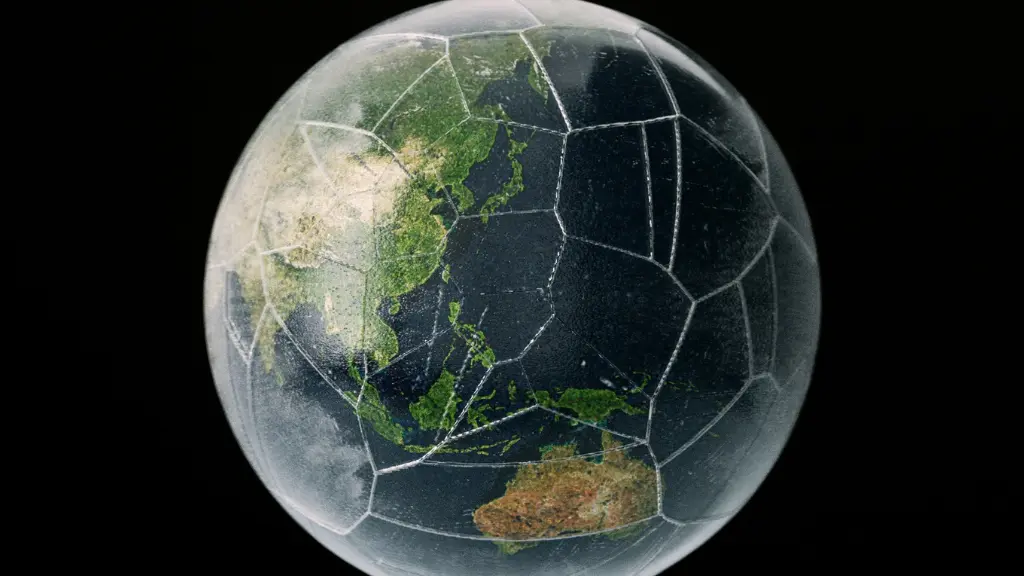

Ο πυρήνας της Γης είναι ένα συναρπαστικό και μυστηριώδες μέρος του πλανήτη μας. Ως το ίδιο το κέντρο του γήινος πυρήνας, παίζει καθοριστικό ρόλο στη συνολική δομή και συμπεριφορά του πλανήτη. Ο πυρήνας αποτελείται από δύο διακριτά μέρη: τον εσωτερικό και τον εξωτερικό πυρήνα.
Ο εσωτερικός πυρήνας είναι μια συμπαγής σφαίρα που αποτελείται από σίδηρο και νικέλιο, με διάμετρο περίπου 1.200 χιλιομέτρων. Περιβάλλεται από τον εξωτερικό πυρήνα, ο οποίος είναι ένα στρώμα λιωμένου μετάλλου που έχει πάχος περίπου 2.300 χιλιομέτρων. Μαζί, αυτά τα δύο στρώματα αποτελούν περίπου 15% του συνολικού όγκου της Γης. Ο πυρήνας είναι επίσης απίστευτα ζεστός, με θερμοκρασίες που φτάνουν έως και 6.000 βαθμούς Κελσίου στο κέντρο.
Οι επιστήμονες μελετούν τον πυρήνα της Γης εδώ και δεκαετίες, αλλά υπάρχουν ακόμα πολλά που παραμένουν άγνωστα. Ωστόσο, οι πρόσφατες εξελίξεις στην τεχνολογία επέτρεψαν στους ερευνητές να κατανοήσουν καλύτερα αυτήν τη μυστηριώδη περιοχή. Σε αυτό το άρθρο, θα εξερευνήσω τον πυρήνα της Γης με περισσότερες λεπτομέρειες, συμπεριλαμβανομένης της σύνθεσης, της συμπεριφοράς και του ρόλου που παίζει στη διαμόρφωση του πλανήτη μας.

Ο πυρήνας της Γης είναι το κεντρικό τμήμα του πλανήτη μας, που βρίσκεται κάτω από τον μανδύα και τον φλοιό. Χωρίζεται σε δύο στρώματα: τον συμπαγή εσωτερικό πυρήνα και τον υγρό εξωτερικό πυρήνα. Η σύνθεση του πυρήνα της Γης αποτελεί θέμα μεγάλου ενδιαφέροντος για τους επιστήμονες, καθώς μας βοηθά να κατανοήσουμε τον σχηματισμό και την εξέλιξη του πλανήτη μας.
Η χημική σύνθεση του πυρήνα της Γης πιστεύεται ότι είναι κυρίως σίδηρος (Fe) και νικέλιο (Ni). Αυτά τα στοιχεία αποτελούν περισσότερο από 80% της μάζας του πυρήνα, με μικρότερες ποσότητες άλλων στοιχείων όπως το θείο (S), το οξυγόνο (O) και το πυρίτιο (Si). Η ακριβής σύνθεση του πυρήνα είναι δύσκολο να προσδιοριστεί, καθώς είναι αδύνατο να τον παρατηρήσουμε άμεσα. Ωστόσο, οι επιστήμονες κατάφεραν να βγάλουν συμπεράσματα σχετικά με τη σύνθεση του πυρήνα με βάση σεισμικά δεδομένα και πειράματα.
Ο συμπαγής εσωτερικός πυρήνας της Γης πιστεύεται ότι αποτελείται κυρίως από σίδηρο, με μικρότερες ποσότητες νικελίου και άλλων στοιχείων. Υπολογίζεται ότι έχει ακτίνα περίπου 1.220 χιλιομέτρων και θερμοκρασία περίπου 5.000 βαθμούς Κελσίου. Παρά την υψηλή θερμοκρασία του, ο εσωτερικός πυρήνας παραμένει σταθερός λόγω της τεράστιας πίεσης που δέχεται.
Ο υγρός εξωτερικός πυρήνας του πυρήνα της γης αποτελείται επίσης κυρίως από σίδηρο και νικέλιο, αλλά περιέχει επίσης ελαφρύτερα στοιχεία όπως θείο και οξυγόνο. Υπολογίζεται ότι έχει πάχος περίπου 2.300 χιλιόμετρα και θερμοκρασία περίπου 4.000 βαθμούς Κελσίου. Το μαγνητικό πεδίο της Γης, το οποίο μας προστατεύει από την επικίνδυνη ηλιακή ακτινοβολία, δημιουργείται από τον εξωτερικό πυρήνα.
Συμπερασματικά, η σύνθεση του γήινος πυρήνας αποτελείται κυρίως από σίδηρο και νικέλιο, με μικρότερες ποσότητες άλλων στοιχείων. Ο στερεός εσωτερικός πυρήνας και ο υγρός εξωτερικός πυρήνας παίζουν σημαντικούς ρόλους στη γεωλογία της Γης και στο μαγνητικό πεδίο του πυρήνα της γης. Απαιτείται περαιτέρω έρευνα για την πλήρη κατανόηση της σύνθεσης και της συμπεριφοράς του πυρήνα της Γης.

Ως γεωφυσικός, πάντα με γοήτευε η δυναμική του πυρήνα της γης. Ο πυρήνας είναι ένα πολύπλοκο σύστημα που αποτελείται από δύο ξεχωριστά στρώματα, τον εσωτερικό πυρήνα και τον εξωτερικό πυρήνα. Σε αυτή την ενότητα, θα εξερευνήσω τις κινήσεις και τη μεταφορά θερμότητας μέσα στον πυρήνα.
Ο πυρήνας της Γης βρίσκεται συνεχώς σε κίνηση. Το μαγνητικό πεδίο του πυρήνα της γης, το οποίο μας προστατεύει από την επικίνδυνη ηλιακή ακτινοβολία, δημιουργείται από τον εξωτερικό πυρήνα. Η κίνηση του εξωτερικού πυρήνα καθοδηγείται από τη θερμότητα που παράγεται από τον εσωτερικό πυρήνα και την ψύξη του εξωτερικού πυρήνα στην κορυφή. Αυτή η κίνηση είναι γνωστή ως συναγωγή.
Η περιστροφή της Γης παίζει επίσης βασικό ρόλο στην κίνηση του πυρήνα. Το φαινόμενο Coriolis προκαλεί τα ρεύματα μεταφοράς να περιστρέφονται κατά τη φορά των δεικτών του ρολογιού στο βόρειο ημισφαίριο και αριστερόστροφα στο νότιο ημισφαίριο. Αυτή η περιστροφή δημιουργεί ένα φαινόμενο δυναμό, το οποίο δημιουργεί το μαγνητικό πεδίο της Γης.
Ο εσωτερικός πυρήνας, από την άλλη πλευρά, περιστρέφεται ανεξάρτητα από τον εξωτερικό πυρήνα. Η περιστροφή του εσωτερικού πυρήνα είναι ελαφρώς ταχύτερη από την περιστροφή της επιφάνειας της Γης, ολοκληρώνοντας μια πλήρη περιστροφή κάθε 24 ώρες. Αυτή η περιστροφή δημιουργεί μια μικρή ποσότητα ενέργειας, η οποία πιστεύεται ότι είναι υπεύθυνη για τη διατήρηση του μαγνητικού πεδίου του πυρήνα.
Η επιστήμη του πυρήνα της γης είναι εξαιρετικά καυτή, με θερμοκρασίες να φτάνουν τους 6.000 βαθμούς Κελσίου. Η θερμότητα παράγεται από τη διάσπαση των ραδιενεργών ισοτόπων και η υπολειπόμενη θερμότητα από το σχηματισμό της Γης. Στη συνέχεια, η θερμότητα μεταφέρεται από τον εσωτερικό πυρήνα στον εξωτερικό πυρήνα μέσω αγωγιμότητας.
Η ψύξη του εξωτερικού πυρήνα στην κορυφή δημιουργεί μια κλίση θερμοκρασίας, η οποία οδηγεί τα ρεύματα μεταφοράς. Καθώς το ζεστό υλικό ανεβαίνει, ψύχεται και βυθίζεται πίσω, δημιουργώντας έναν συνεχή κύκλο μεταφοράς θερμότητας.
Συμπερασματικά, η δυναμική του πυρήνα της Γης είναι ένα σύνθετο σύστημα κινήσεων και μεταφοράς θερμότητας. Οι κινήσεις του πυρήνα καθοδηγούνται από τη μεταφορά και την περιστροφή της Γης, ενώ η θερμότητα παράγεται από τη διάσπαση των ραδιενεργών ισοτόπων και η υπολειπόμενη θερμότητα από το σχηματισμό της Γης. Η κατανόηση της δυναμικής του πυρήνα είναι ζωτικής σημασίας για την κατανόηση του μαγνητικού πεδίου της Γης και των διεργασιών που διαμορφώνουν τον πλανήτη μας.

Ως επιστήμονας της Γης, βρίσκω τη μελέτη του μαγνητικού πεδίου της Γης συναρπαστική. Το μαγνητικό πεδίο είναι μια σημαντική πτυχή του πλανήτη μας και παίζει καθοριστικό ρόλο στην καθημερινή μας ζωή. Σε αυτή την ενότητα, θα συζητήσω τον ρόλο του πυρήνα της Γης στη δημιουργία και τη διατήρηση του μαγνητικού πεδίου.
Το μαγνητικό πεδίο της Γης προκύπτει από την κίνηση του λιωμένου σιδήρου μέσα στον εξωτερικό πυρήνα. Ο εξωτερικός πυρήνας είναι ένα στρώμα υγρού σιδήρου που περιβάλλει τον στερεό εσωτερικό πυρήνα. Η κίνηση του λιωμένου σιδήρου δημιουργεί ηλεκτρικά ρεύματα, τα οποία με τη σειρά τους παράγουν το μαγνητικό πεδίο.
Το μαγνητικό πεδίο δεν είναι στατικό, αλλά αλλάζει συνεχώς. Οι μαγνητικοί πόλοι μπορούν να μετακινηθούν και ακόμη και να αντιστρέψουν την πολικότητα με την πάροδο του χρόνου. Αυτές οι αλλαγές οφείλονται στην πολύπλοκη δυναμική του πυρήνα της Γης και στις αλληλεπιδράσεις του με τον μανδύα και τον φλοιό.
Οι γεωμαγνητικές ανατροπές είναι οι πιο δραματικές αλλαγές στο μαγνητικό πεδίο της Γης. Κατά τη διάρκεια μιας αντιστροφής, το μαγνητικό πεδίο εξασθενεί και οι μαγνητικοί πόλοι αλλάζουν θέση. Η τελευταία ανατροπή συνέβη πριν από περίπου 780.000 χρόνια και οι επιστήμονες προσπαθούν ακόμη να κατανοήσουν τους μηχανισμούς που προκαλούν αυτές τις ανατροπές.
Μια θεωρία είναι ότι οι αναστροφές προκαλούνται από αλλαγές στη ροή του λιωμένου σιδήρου στον εξωτερικό πυρήνα. Καθώς η ροή αλλάζει, το μαγνητικό πεδίο εξασθενεί και τελικά αντιστρέφεται. Μια άλλη θεωρία είναι ότι οι ανατροπές προκαλούνται από τις αλληλεπιδράσεις μεταξύ του πυρήνα και του μανδύα.
Συμπερασματικά, το μαγνητικό πεδίο του πυρήνα της γης είναι ένα πολύπλοκο και δυναμικό σύστημα που δημιουργείται και διατηρείται από την κίνηση του λιωμένου σιδήρου στον εξωτερικό πυρήνα. Το μαγνητικό πεδίο παίζει καθοριστικό ρόλο στην καθημερινή μας ζωή, από την καθοδήγηση των πυξίδων μέχρι την προστασία μας από την επιβλαβή ηλιακή ακτινοβολία. Η κατανόηση του ρόλου του πυρήνα στον μαγνητισμό της Γης είναι ένας σημαντικός τομέας μελέτης για τους επιστήμονες της Γης.

Ως επιστήμονας της γης, βρίσκω τη μελέτη του πυρήνα της γης συναρπαστική. Ο πυρήνας της Γης είναι το πιο εσωτερικό μέρος του πλανήτη μας, που αποτελείται από έναν συμπαγή εσωτερικό πυρήνα και έναν υγρό εξωτερικό πυρήνα. Ο πυρήνας αποτελεί περίπου 15% του όγκου της Γης και 32% της μάζας της. Παρά τη σπουδαιότητά του, η μελέτη του πυρήνα της Γης είναι ένα δύσκολο έργο λόγω του απρόσιτου του.
Μία από τις κύριες μεθόδους που χρησιμοποιούνται για τη μελέτη του πυρήνα της γης είναι η ανάλυση σεισμικών κυμάτων. Τα σεισμικά κύματα είναι κύματα ενέργειας που ταξιδεύουν στο εσωτερικό της Γης και μπορούν να παρέχουν πολύτιμες πληροφορίες για τις ιδιότητες του πυρήνα της Γης. Αναλύοντας τους χρόνους ταξιδιού και τα πλάτη των σεισμικών κυμάτων, οι επιστήμονες μπορούν να συμπεράνουν την πυκνότητα, τη θερμοκρασία και τη σύνθεση του πυρήνα της Γης.
Μια άλλη μέθοδος που χρησιμοποιείται για τη μελέτη του πυρήνα της γης είναι η υπολογιστική προσομοίωση. Αυτό περιλαμβάνει τη χρήση μοντέλων υπολογιστή για την προσομοίωση της συμπεριφοράς του πυρήνα της Γης κάτω από διαφορετικές συνθήκες. Μεταβάλλοντας παραμέτρους όπως η θερμοκρασία, η πίεση και η σύνθεση, οι επιστήμονες μπορούν να αποκτήσουν γνώσεις σχετικά με τη δυναμική του πυρήνα της Γης και πώς επηρεάζει το γήινο μαγνητικό πεδίο.
Συμπερασματικά, η μελέτη του πυρήνα της γης είναι μια πολύπλοκη και προκλητική εργασία που απαιτεί τη χρήση πολλαπλών μεθόδων και τεχνικών. Μέσω της ανάλυσης σεισμικών κυμάτων και της υπολογιστικής προσομοίωσης, οι επιστήμονες αποκτούν καλύτερη κατανόηση του πυρήνα της Γης και του ρόλου του στη διαμόρφωση του πλανήτη στον οποίο ζούμε.

Ως κάποιος που έχει μελετήσει τον πυρήνα της γης, μπορώ με βεβαιότητα να πω ότι ο πυρήνας είναι ένα από τα πιο συναρπαστικά και σημαντικά μέρη του πλανήτη μας. Βρίσκεται στο κέντρο της Γης και αποτελείται από δύο πυρήνες σε στρώματα γης: τον εσωτερικό και τον εξωτερικό πυρήνα.
Το όριο μεταξύ του πυρήνα της γης και του μανδύα είναι γνωστό ως όριο πυρήνα-μανδύα. Βρίσκεται περίπου 2.900 χιλιόμετρα κάτω από την επιφάνεια της Γης. Το όριο χαρακτηρίζεται από μια απότομη αύξηση της πυκνότητας και μια αλλαγή στη συμπεριφορά των σεισμικών κυμάτων που διέρχονται από αυτό.
Το όριο πυρήνα-μανδύα είναι μια πολύ σημαντική περιοχή μελέτης για γεωλόγους και σεισμολόγους. Πιστεύεται ότι το όριο παίζει καθοριστικό ρόλο στην κίνηση των τεκτονικών πλακών και στο σχηματισμό ηφαιστειακής δραστηριότητας. Το όριο πιστεύεται επίσης ότι είναι υπεύθυνο για τη δημιουργία του μαγνητικού πεδίου της Γης.
Οι αλληλεπιδράσεις μεταξύ του πυρήνα και του φλοιού είναι επίσης πολύ σημαντικές. Η θερμότητα του πυρήνα της γης οδηγεί την κίνηση των τεκτονικών πλακών, η οποία με τη σειρά της διαμορφώνει την επιφάνεια της Γης. Ο πυρήνας παίζει επίσης ρόλο στο σχηματισμό των βουνών, καθώς η κίνηση των τεκτονικών πλακών μπορεί να προκαλέσει την λωρίδα και την αναδίπλωση του φλοιού.
Επιπλέον, το μαγνητικό πεδίο του πυρήνα της γης είναι υπεύθυνο για την προστασία της Γης από τις βλαβερές συνέπειες του ηλιακού ανέμου και της κοσμικής ακτινοβολίας. Χωρίς αυτό το μαγνητικό πεδίο, η ζωή στη Γη θα ήταν πολύ πιο δύσκολη, αν όχι αδύνατη.
Συνολικά, ο πυρήνας της γης είναι ένα κρίσιμο μέρος του εσωτερικού της Γης. Οι αλληλεπιδράσεις του με τον μανδύα και τον φλοιό είναι υπεύθυνες για πολλές από τις γεωλογικές διεργασίες που διαμορφώνουν τον πλανήτη μας. Μέσα από συνεχή μελέτη και έρευνα, μπορούμε να κατανοήσουμε καλύτερα τον πυρήνα και τον ρόλο του στην ιστορία και το μέλλον του πλανήτη μας.

Ως κάποιος που έχει μελετήσει τον πυρήνα του πυρήνα του πλανήτη γη, μπορώ με βεβαιότητα να πω ότι έχει σημαντική επιρροή στα επιφανειακά φαινόμενα. Σε αυτή την ενότητα, θα συζητήσω δύο βασικούς τρόπους με τους οποίους ο πυρήνας επηρεάζει την επιφάνεια της Γης: την ηφαιστειακή δραστηριότητα και τις τεκτονικές κινήσεις.
Ο πυρήνας της γης παίζει καθοριστικό ρόλο στη δημιουργία ηφαιστειακής δραστηριότητας. Το μάγμα, το οποίο είναι λιωμένο πέτρωμα που βρίσκεται κάτω από την επιφάνεια της Γης, δημιουργείται από την τήξη των πετρωμάτων στο μανδύα και τον φλοιό. Αυτή η τήξη προκαλείται από τις υψηλές θερμοκρασίες και πιέσεις που υπάρχουν βαθιά μέσα στη Γη, οι οποίες τελικά παράγονται από τη θερμότητα που απελευθερώνεται από τον πυρήνα.
Ο πυρήνας της γης επηρεάζει επίσης τη σύνθεση του μάγματος. Ο πυρήνας αποτελείται κυρίως από σίδηρο και νικέλιο και αυτά τα στοιχεία πιστεύεται ότι είναι η πηγή του σιδήρου και του νικελίου που βρίσκονται στο μάγμα. Επιπλέον, το μαγνητικό πεδίο του πυρήνα μπορεί να επηρεάσει την κίνηση του μάγματος, το οποίο με τη σειρά του μπορεί να επηρεάσει τη θέση και την ένταση των ηφαιστειακών εκρήξεων.
Ο πυρήνας της γης παίζει επίσης σημαντικό ρόλο στις τεκτονικές κινήσεις, οι οποίες είναι οι κινήσεις των πλακών του φλοιού της Γης. Η θερμότητα του πυρήνα πιστεύεται ότι είναι ο κύριος οδηγός αυτών των κινήσεων, καθώς προκαλεί ρεύματα μεταφοράς στον μανδύα. Αυτά τα ρεύματα, με τη σειρά τους, οδηγούν την κίνηση των πλακών του φλοιού.
Ο πυρήνας της γης επηρεάζει επίσης τη σύνθεση και την αντοχή των πλακών του φλοιού. Η θερμότητα που παράγεται από τον πυρήνα κάνει τα πετρώματα στο μανδύα και τον φλοιό να είναι πιο όλκιμο, πράγμα που σημαίνει ότι παραμορφώνονται πιο εύκολα. Αυτό μπορεί να οδηγήσει στο σχηματισμό ρηγμάτων και θραυσμάτων στις πλάκες του φλοιού, που μπορεί τελικά να οδηγήσουν σε σεισμούς.
Συμπερασματικά, ο πυρήνας του πυρήνα της γης έχει σημαντική επίδραση στα επιφανειακά φαινόμενα, ιδιαίτερα την ηφαιστειακή δραστηριότητα και τις τεκτονικές κινήσεις. Η κατανόηση του ρόλου του πυρήνα σε αυτές τις διεργασίες είναι ζωτικής σημασίας για την πρόβλεψη και τον μετριασμό των επιπτώσεων των φυσικών καταστροφών, όπως οι ηφαιστειακές εκρήξεις και οι σεισμοί.

Ως γεωλόγος, θεωρώ ότι ο πυρήνας της γης είναι ένα συναρπαστικό θέμα. Δεν επηρεάζει μόνο το μαγνητικό πεδίο του πλανήτη αλλά έχει επίσης αντίκτυπο στους ωκεανούς. Σε αυτή την ενότητα, θα συζητήσω τη σχέση μεταξύ του πυρήνα της Γης και των ωκεανών.
Ο πυρήνας της γης παράγει θερμότητα, η οποία μεταφέρεται στην επιφάνεια μέσω μεταφοράς. Αυτή η θερμότητα οδηγεί τη θερμοαληνική κυκλοφορία, η οποία είναι υπεύθυνη για την κίνηση του νερού στους ωκεανούς. Η κυκλοφορία της θερμοαλίνης καθοδηγείται από διαφορές στη θερμοκρασία και την αλατότητα, οι οποίες δημιουργούν κλίσεις πυκνότητας στον ωκεανό.
Το ζεστό νερό από τον ισημερινό ρέει προς τους πόλους, όπου ψύχεται και βυθίζεται στον πυθμένα του ωκεανού. Αυτό το κρύο νερό στη συνέχεια ρέει πίσω προς τον ισημερινό, ολοκληρώνοντας την κυκλοφορία. Αυτή η διαδικασία παίζει καθοριστικό ρόλο στη ρύθμιση του κλίματος του πυρήνα της γης με τη διανομή θερμότητας σε όλο τον πλανήτη.
Ο πυρήνας της Γης έχει επίσης αντίκτυπο στις αλλαγές της στάθμης της θάλασσας. Η βαρυτική έλξη της Σελήνης και του Ήλιου προκαλεί παλίρροιες, οι οποίες μπορεί να επηρεαστούν από αλλαγές στο μαγνητικό πεδίο της Γης. Το μαγνητικό πεδίο δημιουργείται από την κίνηση του λιωμένου σιδήρου στον πυρήνα της γης, ο οποίος μπορεί να επηρεαστεί από εξωτερικούς παράγοντες όπως οι ηλιακές καταιγίδες.
Αλλαγές στη στάθμη της θάλασσας μπορεί επίσης να προκληθούν από το λιώσιμο των παγετώνων και των πάγων, το οποίο επηρεάζεται από τον πυρήνα της Γης. Το λιώσιμο των πάγων μπορεί να προκαλέσει αλλαγές στην κατανομή της μάζας στην επιφάνεια του πυρήνα της γης, που μπορεί να επηρεάσει την περιστροφή και το βαρυτικό πεδίο του πλανήτη.
Συμπερασματικά, ο πυρήνας της γης παίζει σημαντικό ρόλο στη λειτουργία των ωκεανών. Η θερμική κυκλοφορία και οι αλλαγές της στάθμης της θάλασσας είναι μόνο δύο παραδείγματα της πολύπλοκης σχέσης μεταξύ του πυρήνα της Γης και των ωκεανών. Ως γεωλόγος, θεωρώ ότι αυτή η σχέση είναι ένα συναρπαστικό θέμα για περαιτέρω μελέτη.

Ως ερευνητής στην επιστήμη του πυρήνα της Γης, είμαι ενθουσιασμένος για τις μελλοντικές δυνατότητες για εξερεύνηση και ανακάλυψη. Υπάρχουν ακόμη τόσα πολλά που δεν γνωρίζουμε για την εσωτερική λειτουργία του πλανήτη μας και πιστεύω ότι η συνεχής έρευνα και εξερεύνηση θα οδηγήσει σε νέες ιδέες και σε μια βαθύτερη κατανόηση του πυρήνα της Γης.
Ένας τομέας ιδιαίτερου ενδιαφέροντος είναι η μελέτη των σεισμικών κυμάτων. Αναλύοντας τον τρόπο με τον οποίο τα σεισμικά κύματα διασχίζουν τον πυρήνα της γης, μπορούμε να αποκτήσουμε πολύτιμες πληροφορίες για τη σύνθεση και τη δομή του πυρήνα. Η συνεχιζόμενη έρευνα σε αυτόν τον τομέα θα μπορούσε να οδηγήσει σε νέες ανακαλύψεις σχετικά με τις ιδιότητες του πυρήνα και τις διεργασίες που λαμβάνουν χώρα μέσα σε αυτόν.
Μια άλλη πολλά υποσχόμενη οδός για μελλοντική έρευνα είναι η χρήση μοντελοποίησης και προσομοίωσης υπολογιστή. Δημιουργώντας λεπτομερή μοντέλα του πυρήνα της γης, μπορούμε να προσομοιώσουμε τη συμπεριφορά διαφορετικών υλικών και να δοκιμάσουμε διάφορες υποθέσεις σχετικά με τις διεργασίες του πυρήνα. Αυτή η προσέγγιση έχει ήδη αποφέρει κάποια συναρπαστικά αποτελέσματα και πιστεύω ότι η συνεχής επένδυση σε αυτόν τον τομέα θα οδηγήσει σε ακόμη περισσότερες ανακαλύψεις.
Επιπλέον, πιστεύω ότι υπάρχουν ακόμη πολλά που πρέπει να μάθουμε από την άμεση εξερεύνηση του πυρήνα της γης. Αν και αυτό είναι ένα δύσκολο έργο, αναδύονται νέες τεχνολογίες και τεχνικές που θα μπορούσαν να το καταστήσουν δυνατό. Για παράδειγμα, η ανάπτυξη προηγμένων τεχνικών και υλικών διάτρησης θα μπορούσε να μας επιτρέψει να διεισδύσουμε βαθύτερα στον φλοιό της Γης και να φτάσουμε στον πυρήνα. Ομοίως, οι εξελίξεις στη ρομποτική και την τηλεπισκόπηση θα μπορούσαν να μας επιτρέψουν να εξερευνήσουμε τον πυρήνα χωρίς να εισέλθουμε φυσικά σε αυτόν.

Γενικά, είμαι αισιόδοξος για το μέλλον του Γήινος πυρήνας την επιστήμη και τις δυνατότητες για νέες ανακαλύψεις και ιδέες. Συνεχίζοντας να επενδύουμε στην έρευνα και την εξερεύνηση, μπορούμε να εμβαθύνουμε την κατανόησή μας για τον πλανήτη μας και τις δυνάμεις που τον διαμορφώνουν. Δείτε περισσότερα άρθρα σαν αυτό κάνοντας κλικ εδώ: Cole Parmer Antylia: A Detailed Review.